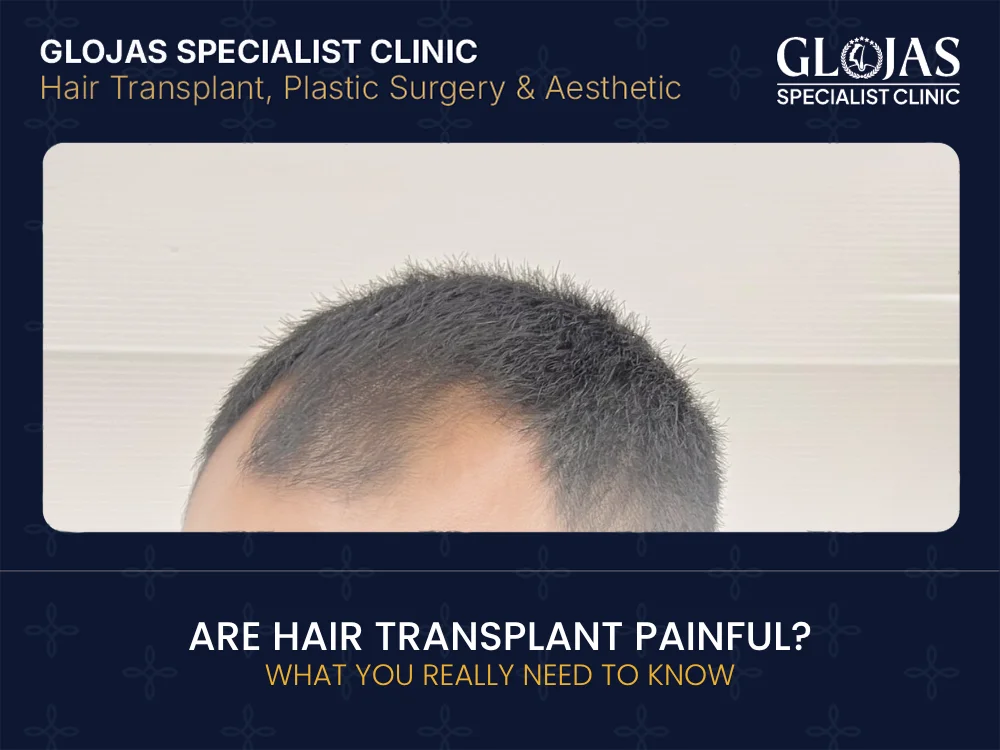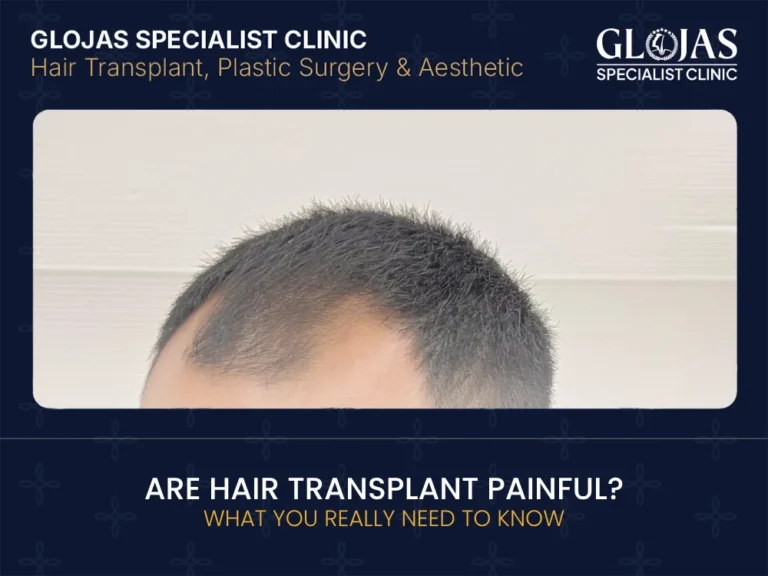If you’re searching for “hair transplant painful,” you’re not alone — many people considering hair restoration wonder how much pain they’ll feel. In this post, we’ll explore in detail the pain (or lack thereof) during and after the surgery, the factors that influence discomfort, how to manage it, and real patient experiences. We aim to answer your questions with clarity, backed by credible sources and clinical insights.
How Is a Hair Transplant Painful (and When)?
When asking how hair transplant painful is a hair transplant, the truth is: very little, if done under skilled hands and with proper anaesthesia. The main discomfort tends to arise from the initial injections of local anaesthesia — similar to getting a dental shot or vaccination. Once the scalp is fully numbed, most patients feel only pressure or mild tugging during follicle extraction and placement.
Because hair transplant is a surgical procedure, it would be misleading (and against ISHRS guidelines) to advertise it as entirely “painless.” Rather, modern techniques aim to minimize pain to very manageable levels.
Timeline of Sensation / Discomfort
Phase | What You Might Feel | Duration |
During anaesthetic injections | Sharp sting or pinch | Brief, seconds to a minute |
Surgical phase (after numbing) | Pressure, tugging, vibration | Typically negligible pain |
First 24–48 hours post-op | Mild soreness, tightness, tender scalp | Common, manageable |
Days 3–7 | Tingling, itching, mild discomfort | Subsides in most cases |
After 1 week onward | Typically minimal or no pain | Most patients resume normal life |
Most patients don’t need strong prescription painkillers beyond the first day or two; over-the-counter analgesics like ibuprofen or acetaminophen are often sufficient.
Techniques & Their Impact on Hair Transplant Painful: FUE vs FUT vs DHI
The type of hair transplant painful technique you choose can influence how much discomfort you feel, both during and after.
- FUE (Follicular Unit Extraction / Excision): Involves removing individual follicular units via small punch incisions. Because it’s less invasive and doesn’t involve a linear incision, post-op discomfort and the need for pain meds are often lower.
- FUT (“Strip” method): Involves excising a strip of scalp tissue, then suturing the donor area closed. This can lead to more post-operative pain or tightness along the suture line.
- DHI (Direct Hair Implantation): A variant of FUE where grafts are implanted directly using a specialized pen-like tool. Pain profile is similar to FUE, with the main discomfort during anaesthesia and early healing.
In short: FUE / DHI generally offer lower discomfort and faster recovery than FUT, especially in the early days after surgery. But the actual experience also depends heavily on the surgeon, graft count, scalp condition, and post-op care.

What Influences How Much Hair Transplant Painful You Actually Experience
Even with excellent technique, pain perception is subjective. Here are key factors:
- Pain tolerance: Some people are more sensitive; others barely notice minor discomfort.
- Graft count / session length: A session with many grafts or very long duration may result in more swelling, soreness, or fatigue.
- Surgeon skill & technique: The precision of the incisions, handling of tissue, and speed all impact trauma and post-op sensation.
- Use of sedation or calming techniques: Some clinics offer light sedation or breathing techniques to reduce anxiety and mitigate pain perception.
- Post-op care & swelling: Inflammation and swelling can exacerbate sensations. Cold compresses, head elevation, and gentle care help reduce discomfort.
Interestingly, one study suggested controlled breathing during local anaesthetic injection can lower pain perception at the donor site.
Real Patient Experiences & What They Say
“It is grueling because it can take up to 8 hours, but the most you will feel is slight discomfort.”
Many patients report that once the scalp is numbed, the procedure is tolerable and even “boring” rather than hair transplant painful. Some, however, do recall the anaesthesia injections as the more uncomfortable part — a quick pinch that passes.
Notably, some public figures have metaphorically compared the anesthesia shot to extreme pain — but these are anecdotal and not typical.
Tips to Minimize Pain and Maximize Comfort
Undergoing a hair transplant can be a transformative experience, and managing your comfort both during and after the procedure is key to a smooth recovery. Here are some expert-backed tips to help minimize discomfort and promote optimal healing:
Choose a Certified, Experienced Surgeon
Your comfort begins with the surgeon you choose. Selecting a board-certified hair restoration specialist — ideally certified by the American Board of Hair Restoration Surgery (ABHRS) or a member of the International Society of Hair Restoration Surgery (ISHRS) — ensures that your procedure is handled with the highest standards of safety, precision, and care. These credentials reflect advanced training, adherence to strict ethical guidelines, and extensive hands-on experience with local anesthesia and patient comfort techniques.
Ask About Sedation Options
If you’re anxious about discomfort, discuss sedation options with your clinic beforehand. Many modern clinics now offer light oral or IV sedation during the initial anesthetic injections to make the process virtually painless. This gentle sedation helps you stay calm and relaxed without deep anesthesia, allowing you to remain responsive while easing anxiety and discomfort.
Stay Relaxed and Practice Controlled Breathing
Your mindset plays a powerful role in your perception of pain. Staying relaxed, maintaining a calm attitude, and using controlled breathing techniques can significantly reduce discomfort during anesthesia administration. Deep, slow breaths signal your nervous system to relax, lowering stress hormones and helping you feel more at ease throughout the procedure.
Use Cold Compresses and Elevate Your Head
Mild swelling is common after a hair transplant. To keep this under control, apply cold compresses around (but not directly on) the treated area as instructed by your surgeon. Additionally, sleep with your head elevated on extra pillows for the first few nights. This helps fluid drain away from the scalp, reducing pressure, swelling, and tenderness.
Take Prescribed Pain Medications
Always follow your surgeon’s medication plan precisely. Most patients experience only mild soreness, which can be easily managed with prescribed pain relievers. However, it’s important to avoid over-the-counter NSAIDs (such as aspirin or ibuprofen) and certain supplements like fish oil, vitamin E, or ginkgo biloba unless specifically cleared by your surgeon, as they may increase bleeding or slow healing.
Follow All Aftercare Instructions Diligently
Your post-operative care routine is crucial for ensuring comfort and protecting your results. Avoid scratching, rubbing, or touching the transplanted area. Do not wear tight hats, helmets, or anything that puts pressure on your scalp during the healing period. Keeping the area clean, following your washing instructions, and attending follow-up appointments will not only enhance comfort but also promote faster recovery and better graft survival.
Does Hair Transplant Painful Affect the Outcome or Graft Survival?
No — the level of pain you feel (within reason) does not negatively impact graft survival or hair growth, provided you follow post-op instructions. Discomfort is often caused by swelling, inflammation, or tissue reaction — not graft failure.
However, excessive rubbing, scratching, infection, or poor post-op care can jeopardize results. That’s why choosing a skilled, ABHRS / ISHRS-certified center matters.
Frequently Asked Questions (10 FAQs)
- Is hair transplant painful during the procedure?
Most patients feel only a quick sting from the anesthetic injections. After that, the scalp is numb, so you’ll feel pressure or tugging—but not sharp pain. - Does FUT hair transplant painful more than FUE?
Yes — FUT, which involves a strip incision and sutures, tends to produce more post-op discomfort than FUE, where extraction is done individually and less trauma is involved. - How long does pain last after a hair transplant?
Mild soreness and tightness generally last 2–7 days. By the end of the first week, most patients report minimal pain. - Will I need strong painkillers, if hair transplant painful?
Rarely. Over-the-counter medications like ibuprofen or acetaminophen often suffice beyond the first 24 hours. - Can I feel the grafts growing?
No — once implantation is done, you should not feel the follicles growing. Discomfort afterward is related to healing, not hair growth. - Will the donor area hair transplant painful more than the recipient site?
It depends. In FUE, there are many small wounds, but they are shallow. In FUT, the donor strip and suture line can be more tender initially. - Does scalp tightness or swelling make it worse?
Yes, swelling can intensify sensations. That’s why anti-inflammatory measures, cold compress, and head elevation are recommended. - Are there long-term pain risks?
Chronic pain is rare. Temporary numbness or altered sensation may occur but usually improves over time. - Does the number of grafts affect hair transplant painful?
Yes — more grafts can mean more micro-injuries, swelling, and longer procedure time, which may slightly increase discomfort. - Can anxiety make it hurt more?
Absolutely. Stress or fear can amplify pain perception. Techniques like calming conversation, breathing exercises, or light sedation help.
Bottom Line & What You Should Know
- The procedures are not highly hair transplant painful, thanks to modern local anesthesia and refined surgical techniques.
- The main discomfort is typically brief — the injection of anesthesia; pain afterward is mild and temporary.
- Technique matters: FUE / DHI tend to offer less post-op discomfort and quicker recovery than FUT.
- Pain levels vary by individual, graft count, scalp condition, and surgeon skill.
- Pain does not generally affect graft survival — good results depend more on technique and post-op care.
If pain is your top concern, it’s wise to choose a clinic certified by ABHRS and aligned with ISHRS standards. A skilled surgeon can make the experience significantly more comfortable.
Why Choose GLOJAS Specialist Clinic?
At GLOJAS Specialist Clinic, our surgeons are ABHRS diplomates and adhere to ISHRS best practices, with over 25 years of expertise in hair restoration. We prioritize patient comfort — from offering sedation options, precise local anaesthesia, optimal technique choice (FUE / DHI), to diligent post-operative care. Your comfort and result both matter.
➡️ Ready to explore a hair transplant with minimal discomfort? Contact GLOJAS Specialist Clinic today for a consultation with certified experts who care.
